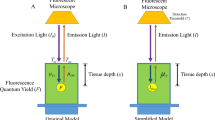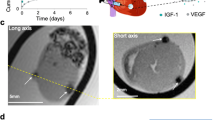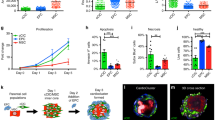Abstract
Animal studies have shown some success in the use of stem cells of diverse origins to treat heart failure and ventricular dysfunction secondary to ischemic injury. The clinical use of these cells is, therefore, promising. In order to develop effective cell therapies, the location, distribution and long-term viability of these cells must be evaluated in a noninvasive manner. MRI of cells labeled with magnetically visible contrast agents after either direct injection or local or intravenous infusion has the potential to fulfill this goal. In this Review, techniques for labeling and imaging a variety of cells will be discussed. Particular attention will be given to the advantages and limitations of various contrast agents and passive and facilitated cell-labeling methods, as well as to imaging techniques that produce negative and positive contrast, and the effect on image quantification of compartmentalization of contrast agents within the cell.
Key Points
-
Local transplantation of stem cells has the potential to treat many cardiovascular diseases
-
Noninvasive tracking of labeled therapeutic cells will permit assessment of local engraftment
-
The labeling of therapeutic cells with imaging labels while maintaining cell viability requires use of both passive and facilitated transfection methods
-
MRI labels such as iron oxide nanoparticles provide strong MRI signal alteration while imparting low cellular toxic effects
This is a preview of subscription content, access via your institution
Access options
Subscribe to this journal
Receive 12 print issues and online access
$209.00 per year
only $17.42 per issue
Buy this article
- Purchase on Springer Link
- Instant access to full article PDF
Prices may be subject to local taxes which are calculated during checkout





Similar content being viewed by others
References
Fernandez-Aviles F et al. (2004) Experimental and clinical regenerative capability of human bone marrow cells after myocardial infarction. Circ Res 95: 742–748
Janssens S et al. (2006) Autologous bone marrow-derived stem-cell transfer in patients with ST-segment elevation myocardial infarction: double-blind, randomised controlled trial. Lancet 367: 113–121
Nagel E et al. (2003) Magnetic resonance perfusion measurements for the noninvasive detection of coronary artery disease. Circulation 108: 432–437
Kim RJ et al. (1999) Relationship of MRI delayed contrast enhancement to irreversible injury, infarct age, and contractile function. Circulation 100: 1992–2002
Rajagopalan S et al. (2002) Magnetic resonance angiographic techniques for the diagnosis of arterial disease. Cardiol Clin 20: 501–512
Frangioni JV et al. (2004) In vivo tracking of stem cells for clinical trials in cardiovascular disease. Circulation 110: 3378–3383
Shen T et al. (1993) Monocrystalline iron oxide nanocompounds (MION): physicochemical properties. Magn Reson Med 29: 599–604
Jung CW et al. (1995) Physical and chemical properties of superparamagnetic iron oxide MR contrast agents: ferumoxides, ferumoxtran, ferumoxsil. Magn Reson Imaging 13: 661–674
Hinds KA et al. (2003) Highly efficient endosomal labeling of progenitor and stem cells with large magnetic particles allows magnetic resonance imaging of single cells. Blood 102: 867–872
Cunningham CH et al. (2005) Positive contrast magnetic resonance imaging of cells labeled with magnetic nanoparticles. Magn Reson Med 53: 999–1005
Mani V et al. (2006) Gradient echo acquisition for superparamagnetic particles with positive contrast (GRASP): sequence characterization in membrane and glass superparamagnetic iron oxide phantoms at 1.5 T and 3T. Magn Reson Med 55: 126–135
Sun R et al. (2005) Physical and biological characterization of superparamagnetic iron oxide- and ultrasmall superparamagnetic iron oxide-labeled cells: a comparison. Invest Radiol 40: 504–513
Daldrup-Link HE et al. (2005) Migration of iron oxide-labeled human hematopoietic progenitor cells in a mouse model: in vivo monitoring with 1.5-T MR imaging equipment. Radiology 234: 197–205
Raynal I et al. (2004) Macrophage endocytosis of superparamagnetic iron oxide nanoparticles: mechanisms and comparison of ferumoxides and ferumoxtran-10. Invest Radiol 39: 56–63
Ralph P et al. (1975) Reticulum cell sarcoma: an effector cell in antibody-dependent cell-mediated immunity. J Immunol 114: 898–905
Fleige G et al. (2002) In vitro characterization of two different ultrasmall iron oxide particles for magnetic resonance cell tracking. Invest Radiol 37: 482–488
Pratten MK and Lloyd JB et al. (1986) Pinocytosis and phagocytosis: the effect of size of a particulate substrate on its mode of capture by rat peritoneal macrophages cultured in vitro. Biochim Biophys Acta 881: 307–313
Metz S et al. (2004) Capacity of human monocytes to phagocytose approved iron oxide MR contrast agents in vitro. Eur Radiol 14: 1851–1858
Zelivyanskaya ML et al. (2003) Tracking superparamagnetic iron oxide labeled monocytes in brain by high-field magnetic resonance imaging. J Neurosci Res 73: 284–295
Shapiro EM et al. (2005) Sizing it up: cellular MRI using micron-sized iron oxide particles. Magn Reson Med 53: 329–338
Wu YL et al. (2006) In situ labeling of immune cells with iron oxide particles: an approach to detect organ rejection by cellular MRI. Proc Natl Acad Sci USA 103: 1852–1857
de Vries IJ et al. (2005) Magnetic resonance tracking of dendritic cells in melanoma patients for monitoring of cellular therapy. Nat Biotechnol 23: 1407–1413
Bulte JW et al. (1999) Neurotransplantation of magnetically labeled oligodendrocyte progenitors: magnetic resonance tracking of cell migration and myelination. Proc Natl Acad Sci USA 96: 15256–15261
Jefferies WA et al. (1984) Transferrin receptor on endothelium of brain capillaries. Nature 312: 162–163
Bulte JW et al. (2001) Magnetodendrimers allow endosomal magnetic labeling and in vivo tracking of stem cells. Nat Biotechnol 19: 1141–1147
Zhang ZY et al. (2000) High-generation polycationic dendrimers are unusually effective at disrupting anionic vesicles: membrane bending model. Bioconjug Chem 11: 805–814
Wilhelm C et al. (2003) Intracellular uptake of anionic superparamagnetic nanoparticles as a function of their surface coating. Biomaterials 24: 1001–1011
Riviere C et al. (2005) Iron oxide nanoparticle-labeled rat smooth muscle cells: cardiac MR imaging for cell graft monitoring and quantitation. Radiology 235: 959–967
Bulte JW et al. (2004) Preparation of magnetically labeled cells for cell tracking by magnetic resonance imaging. Methods Enzymol 386: 275–299
Strand BL et al. (2001) Poly-L-Lysine induces fibrosis on alginate microcapsules via the induction of cytokines. Cell Transplant 10: 263–275
Kalish H et al. (2003) Combination of transfection agents and magnetic resonance contrast agents for cellular imaging: relationship between relaxivities, electrostatic forces, and chemical composition. Magn Reson Med 50: 275–282
Arbab AS et al. (2004) Comparison of transfection agents in forming complexes with ferumoxides, cell labeling efficiency, and cellular viability. Mol Imaging 3: 24–32
Arbab AS et al. (2004) Efficient magnetic cell labeling with protamine sulfate complexed to ferumoxides for cellular MRI. Blood 104: 1217–1223
Arbab AS et al. (2005) Labeling of cells with ferumoxides-protamine sulfate complexes does not inhibit function or differentiation capacity of hematopoietic or mesenchymal stem cells. NMR Biomed 18: 553–559
Arbab AS et al. (2006) Magnetic resonance imaging and confocal microscopy studies of magnetically labeled endothelial progenitor cells trafficking to sites of tumor angiogenesis. Stem Cells 24: 671–678
Anderson SA et al. (2005) Noninvasive MR imaging of magnetically labeled stem cells to directly identify neovasculature in a glioma model. Blood 105: 420–425
Arbab AS et al. (2003) Characterization of biophysical and metabolic properties of cells labeled with superparamagnetic iron oxide nanoparticles and transfection agent for cellular MR imaging. Radiology 229: 838–846
Yocum GT et al. (2005) Effect of human stem cells labeled with ferumoxides-poly-L-lysine on hematologic and biochemical measurements in rats. Radiology 235: 547–552
Frank JA et al. (2004) Methods for magnetically labeling stem and other cells for detection by in vivo magnetic resonance imaging. Cytotherapy 6: 621–625
Zhao M et al. (2002) Differential conjugation of tat peptide to superparamagnetic nanoparticles and its effect on cellular uptake. Bioconjug Chem 13: 840–844
Vives E et al. (1997) A truncated HIV-1 Tat protein basic domain rapidly translocates through the plasma membrane and accumulates in the cell nucleus. J Biol Chem 272: 16010–16017
Fawell S et al. (1994) Tat-mediated delivery of heterologous proteins into cells. Proc Natl Acad Sci USA 91: 664–668
Lewin M et al. (2000) Tat peptide-derivatized magnetic nanoparticles allow in vivo tracking and recovery of progenitor cells. Nat Biotechnol 18: 410–414
Smits PC et al. (2003) Catheter-based intramyocardial injection of autologous skeletal myoblasts as a primary treatment of ischemic heart failure: clinical experience with six-month follow-up. J Am Coll Cardiol 42: 2063–2069
van den Bos EJ et al. (2005) Functional assessment of myoblast transplantation for cardiac repair with magnetic resonance imaging. Eur J Heart Fail 7: 435–443
Zhang Z et al. (2004) High-resolution magnetic resonance imaging of iron-labeled myoblasts using a standard 1.5-T clinical scanner. MAGMA 17: 201–209
Walczak P et al. (2005) Instant MR labeling of stem cells using magnetoelectroporation. Magn Reson Med 54: 769–774
Genove G et al. (2005) A new transgene reporter for in vivo magnetic resonance imaging. Nat Med 11: 450–454
Billotey C et al. (2003) Cell internalization of anionic maghemite nanoparticles: quantitative effect on magnetic resonance imaging. Magn Reson Med 49: 646–654
Bowen CV et al. (2002) Application of the static dephasing regime theory to superparamagnetic iron-oxide loaded cells. Magn Reson Med 48: 52–61
Moore A et al. (2000) Tumoral distribution of long-circulating dextran-coated iron oxide nanoparticles in a rodent model. Radiology 214: 568–574
Posse S (1992) Direct imaging of magnetic field gradients by group spin-echo selection. Magn Reson Med 25: 12–29
Seppenwoolde JH et al. (2003) Passive tracking exploiting local signal conservation: the white marker phenomenon. Magn Reson Med 50: 784–790
Kraitchman DL et al. (2003) In vivo magnetic resonance imaging of mesenchymal stem cells in myocardial infarction. Circulation 107: 2290–2293
Krombach GA et al. (2005) MR-guided percutaneous intramyocardial injection with an MR-compatible catheter: feasibility and changes in T1 values after injection of extracellular contrast medium in pigs. Radiology 235: 487–494
Hill JM et al. (2003) Serial cardiac magnetic resonance imaging of injected mesenchymal stem cells. Circulation 108: 1009–1014
Kraitchman DL et al. (2005) Dynamic imaging of allogeneic mesenchymal stem cells trafficking to myocardial infarction. Circulation 112: 1451–1461
Zhang Z et al. (2005) In vitro imaging of single living human umbilical vein endothelial cells with a clinical 3.0-T MRI scanner. MAGMA 18: 175–185
Heyn C et al. (2005) Detection threshold of single SPIO-labeled cells with FIESTA. Magn Reson Med 53: 312–320
Shapiro EM et al. (2006) In vivo detection of single cells by MRI. Magn Reson Med 55: 242–249
Martin ET et al. (2004) Magnetic resonance imaging and cardiac pacemaker safety at 1.5T. J Am Coll Cardiol 43: 1315–1324
Roguin A et al. (2004) Modern pacemaker and implantable cardioverter/defibrillator systems can be magnetic resonance imaging safe: in vitro and in vivo assessment of safety and function at 1.5 T. Circulation 110: 475–482
Acknowledgements
We are saddened by the recent loss of our colleague Walter J Rogers, PhD, after a battle with leukemia. Dr Rogers was an exemplary friend and colleague who will be sorely missed at the University of Virginia and throughout the scientific community.
Author information
Authors and Affiliations
Corresponding author
Ethics declarations
Competing interests
The authors declare no competing financial interests.
Rights and permissions
About this article
Cite this article
Rogers, W., Meyer, C. & Kramer, C. Technology Insight: in vivo cell tracking by use of MRI. Nat Rev Cardiol 3, 554–562 (2006). https://doi.org/10.1038/ncpcardio0659
Received:
Accepted:
Issue Date:
DOI: https://doi.org/10.1038/ncpcardio0659
This article is cited by
-
Cell sorting microbeads as novel contrast agent for magnetic resonance imaging
Scientific Reports (2022)
-
Ex vivo MRI cell tracking of autologous mesenchymal stromal cells in an ovine osteochondral defect model
Stem Cell Research & Therapy (2019)
-
Cell-assembled (Gd-DOTA)i-triphenylphosphonium (TPP) nanoclusters as a T2 contrast agent reveal in vivo fates of stem cell transplants
Nano Research (2018)
-
Intraarterial route increases the risk of cerebral lesions after mesenchymal cell administration in animal model of ischemia
Scientific Reports (2017)
-
Bioactive magnetic near Infra-Red fluorescent core-shell iron oxide/human serum albumin nanoparticles for controlled release of growth factors for augmentation of human mesenchymal stem cell growth and differentiation
Journal of Nanobiotechnology (2015)



